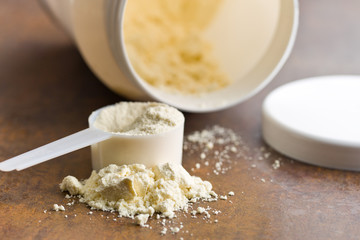FDA (Food)
The Nutrition Labeling and Education Act of 1990 (NLEA) amended Food, Drug & Cosmetic Act, requiring food and dietary supplements to have nutrition labeling.
Dietary Supplement Health and Education Act (DSHEA) of 1994, defined Dietary Supplement and added specific labeling requirements for dietary supplements.
In 1997, several key regulations for statement of identity, nutrition labeling, ingredient labeling, nutrition content and health claims for dietary supplements were implemented.[1]
The 1997 Food and Drug Administration Modernization Act authorizes health claims based on an authoritative statement of a scientific body of the U.S. government with official responsibility for public health protection or research directly related to human nutrition, or the National Academy of Sciences. Such claims may be used after submission of a health claim notification to FDA.
Dietary supplements are classified as food products, but DSHEA stipulates that such products must be labeled as “dietary supplements” and be sold in the form of pills, capsules, tablets, gelcaps, liquids, powders, or other forms, and not be represented for use as conventional foods. Supplements also cannot be marketed as the only item in a meal or diet.
As of March 1999, dietary supplement packages must bear a “Supplement Facts” panel, similar to the “Nutrition Facts” panel mandated for food labels by the Nutrition Labeling and Education Act (NLEA) of 1990. The purpose of this labeling is to provide information about nutrients and other dietary ingredients. The label must list all dietary ingredients and the Daily Values (DV) of the amounts contained in a serving. If no DV has been established for a dietary ingredient, this must be indicated. [2]
If a blend of ingredients is proprietary, the total quantity of ingredients per serving must be stated rather than the amount of each individual ingredient in the blend. If an ingredient is an herbal product, the part of the plant (such as the root or leaf) from which the ingredient is derived must be identified. The common name of the botanical as listed in Herbs of Commerce (American Herbal Products Association, Silver Spring, Md.) may be used; if a botanical is not listed in the book, the Latin binomial name (e.g., Echinacea augustifolia DC) must be used. The following information also must appear on the label: statement of identity, which identifies the contents of the product; net quantity of contents; ingredient list (in descending order by weight); and the name and address of the manufacturer, packer, or distributor (FDA, 1997c). [3]
Under DSHEA, however, dietary supplement ingredients may be sold without undergoing a formal FDA approval process. Although the supplement manufacturer is not required to provide rigorous scientific evidence of safety or efficacy, the manufacturer should be able to provide information to support any labeling claims.[4]
Under the law, claims that are allowed to be used on food and dietary supplement labels fall into three categories: nutrient content claims, health claims and structure/function claims. Disease-related claims are generally not permitted for dietary supplements.
[1] See FDA website, Guidance for Industry, Food, Guidance and Regulation, Guidance Documents and Regulatory Information by Topic, A Dietary Supplement Labeling Guide.
[2] IFT Network, Dietary Supplements: Nutritional and Legal Considerations, July 1, 1999.
[3] IFT Network, Dietary Supplements: Nutritional and Legal Considerations, July 1, 1999
[4] IFT Network, Dietary Supplements: Nutritional and Legal Considerations, July 1, 1999.
By Al Mohajerian | Published April 1, 2016 | Posted in FDA |
Filed Under: Dietary Supplements, FDA (Food), Healthcare
“Food additives (direct, secondary, indirect) are essentially chemically derived, do not have a history of use in foods, and there is no general agreement among the scientific community with regard to their safety for the use that is proposed. Direct food additives are added to food for a technical purpose and have a lasting effect in the food (e.g., the antioxidants BHA/BHT). Secondary direct additives are added for a momentary technical effect and have no lasting effect in the food (e.g., antimicrobial agents, ozone, acidified sodium chlorite). Indirect food additives have the potential to become part of a food through processing or packaging but are not intended to be added to food for an intended technical effect (e.g., coatings and adhesives.)
“A GRAS substance is distinguished from a food additive on the basis of the common knowledge about the safety of the substance for its intended use.” As FDA discussed in a proposed rule to establish a voluntary notification program for GRAS substances (62 Fed. Reg. 18938; April 17, 1997), the data and information relied on to establish the safety of the use of a GRAS substance must be generally available (e.g., through publication in the scientific literature) and there must be a basis to conclude that there is consensus among qualified experts about the safety of the substance for its intended use. Thus, the difference between use of a food additive and use of a GRAS substance relates to the widespread awareness of the data and information about the substance, i.e., who has access to the data and information and who has reviewed those data and information.
1. For a food additive, privately held data and information about the use of the substance are sent by the sponsor to FDA and FDA evaluates those data and information to determine whether they establish that the substance is safe under the conditions of its intended use (21 CFR 171.1).
2. For a GRAS substance, generally available data and information about the use of the substance are known and accepted widely by qualified experts, and there is a basis to conclude that there is consensus among qualified experts that those data and information establish that the substance is safe under the conditions of its intended use. (proposed .170.36 (c)(4)(i)(C)).12
Filed Under: FDA (Food)
Tagged With: FSIS FDA Food

